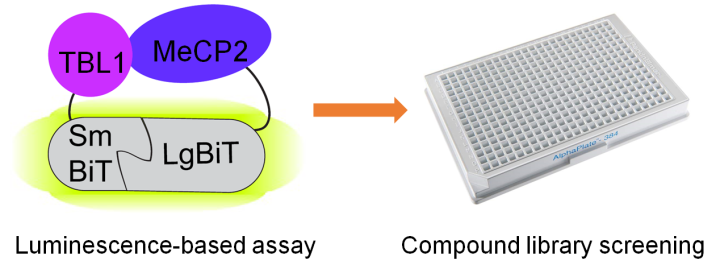A screen for MeCP2-TBL1 interaction inhibitors using a luminescence-based assay
Bird Lab - Scientific Reports.
Authors
Alexander-Howden, B., Zhang, L., van der Sloot, A.M., Tollis, S., St-Cyr, D.J., Sicheri, F., Bird, A.P., Tyers, M., and Lyst, M.J.

Summary of Paper by Lori Koch
MeCP2 duplication syndrome (MDS) is a severe autism-spectrum disorder caused by excessive levels of the protein MeCP2. This protein binds to methylated DNA and recruits the proteins TBL1 and TBLR1 in order to bring about transcriptional repression. Previous studies found that preventing the interaction between MeCP2 and TBL1/TBLR1 reduced toxicity in animal models of the disease. In their recent study published in Scientific Reports, scientists led by Dr. Beatrice Alexander-Howden, Dr. Matthew Lyst and Prof Adrian Bird developed an assay to identify small molecule inhibitors of the MeCP2-TBLR1/TBL1 interaction. The assay involves fusing two fragments of the luciferase enzyme NanoLuc to the proteins of interest, in this case MeCP2 and TBLR1 or TBL1. NanoLuc will produce light when it becomes fully formed as its two fragments are brought together if the proteins of interest interact. They adapted this complementation assay to screen for small molecules that disrupt the MeCP2-TBLR1/TBL1 interaction and therefore reduce luminescence signal. To counterscreen for molecules which may generally reduce NanoLuc activity, they also performed the same screen with another protein pair that was not MeCP2-TBL1. In their initial pilot screen of 995 compounds, they identified 4 molecules that disrupted luminescent signal reproducibly and significantly (by 40-60%). After counterscreening, one compound BDG 34039627 was found to specifically inhibit MeCP2-TBL1. Next, they screened a library of 1981 FDA-approved drugs and identified 5 candidate inhibitors of MeCP2-TBL1. Four out of five of these compounds were found to specifically disrupt MeCP2 in the follow up control screen. This study demonstrates the feasibility and reliability of using this biochemical assay to screen for potentially relevant therapeutic compounds.

